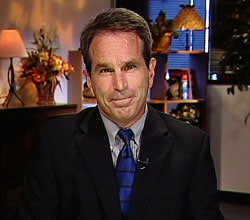The New York Times ran an op-ed last week by Robert Bryce of the Manhattan Institute, a group funded by Koch Industries, ExxonMobil and other polluters to confuse the public about climate change and energy issues. Robert Bryce goes to great lengths to portray solar and wind power as land-hogging energy choices. He suggests that fracked shale gas and nuclear are somehow more environmentally preferable energy options.
This is a common argument from Bryce, who had a similar pro-fracking op-ed in the Wall Street Journal this week, and who has emerged as one of the loudest of a growing cadre of critics of clean energy. Most of these critics are, not surprisingly, affiliated with “institutes” (i.e., front groups) that get money from the dirty energy industries that solar and wind are starting to disrupt.
Bryce’s argument was quickly debunked by the American Wind Energy Association (AWEA), which points out a number of factual errors and omissions in the Manhattan Institute representative’s piece. AWEA was correct to take on Bryce’s misinformation and set the record straight. Climate Progress also picked apart Bryce’s claims in detail.
But one important question remains – why does The New York Times print such misleading opinion pieces without revealing the clear conflict of interest that a Koch/Exxon-funded front group representative has on such matters? Did the Times’ even ask, and does it do so as a matter of standard practice? {C}
If not, the Times could quickly and easily implement and enforce a policy compelling such op-ed contributors to publicly state their financial conflicts of interest. After all, freelance contributors to the news side of the paper are held to such a standard. What’s with the free pass that Bryce got?
The Times is well-regarded as one of the last bastions of journalistic integrity, which is why it’s so troubling to see the paper fail to enforce a reasonable standard of ethical disclosure on Bryce’s prominent op-ed. The Times ought to provide readers with basic information about the conflicts of interest that a contributor might have.
This is about basic ethics, and doesn’t even reach the level of asking the Times to actually verify facts in op-eds – a step that would inform readers about the blatant misrepresentations and distortions of fact made in propaganda pieces like Bryce’s.
It’s not difficult to see that his arguments that wind and solar renewable energy projects take up more land than fossil fuel and nuclear operations are preposterous. Does anyone really believe Bryce’s claim that wind turbines (which each have a very small physical footprint) are more land-intensive than, say, blowing the tops of hundreds of Appalachian mountains to extract coal, or the vast amounts of land swallowed by oil and gas infrastructure, including pipelines, oil rigs, pump stations, and the roads built specifically to move all that drilling equipment around?
If The New York Times had a policy requiring op-ed contributors to answer basic questions about their funding sources and conflicts of interest, perhaps readers wouldn’t be misled by such pieces.
In this case, had the Times’ opinion page staff asked Bryce where his group the Manhattan Institute gets its funding, readers would learn that the groups gets a significant amount of money from dirty energy interests including ExxonMobil and Koch Industries.
How hard is that, really?
Dirty energy interests know they can game the papers, and that’s why front groups like Bryce’s Manhattan Institute and dozens of similar industry PR firms bother to masquerade as think tanks. It’s a decades-old practice stretching all the way back to the call in the 1971 Powell Manifesto to start launching such groups.
By requiring op-ed contributors to disclose financial conflicts, direct or indirect, on the subject of their pieces, the Times would begin to unmask this cottage industry.
In order to set such a policy, the Times would need to look no further than the very standard it applies to its own news staff through its code of ethics:
The Times’ opinion page editors should apply the spirit of that standard on masquerading by asking a few direct questions of op-ed contributors like Bryce about their funding.
By failing to implement this simple standard, the Times enables the printing of industry propaganda on its influential opinion pages.
*Phone and email messages sent by DeSmogBlog to New York Times public editor Arthur Brisbane inquiring about this policy discrepancy have not been answered, but we will update this post when we hear from him.
Subscribe to our newsletter
Stay up to date with DeSmog news and alerts







